NIKKOR - The Thousand and One Nights No.72

The medium telephoto 1:1 Micro lens
for flower photography
Tale 72 will cover the go-to lens for flower and other types of outdoor macro photography, the AI AF Micro-Nikkor 105mm f/2.8S.
by Kouichi Ohshita
I. A 105mm Micro lens
While 105mm medium-telephoto macro lenses are quite popular these days, the first macro lenses for the SLRs that became more commonplace during the 1960s and 70s had more normal focal lengths of around 50 mm. In those days, Nikon released the Micro-Nikkor 55mm f/3.5 for the Nikon F in 1961 and the Micro-Nikkor Auto 55mm f/3.5 with its automatic aperture in 1963, but did not release a 105mm lens for close-up shooting until 1970. Even that Nikkor lens was for use with bellows focusing attachments and had no focusing mechanism.
Photo 2 below shows how bellows attachments work. One end of the light-proof bellows attaches to the lens mount and the other to the camera mount, enabling close-up or macro photography. Positioning the bellows between the lens and camera body makes focusing in a broad range of 100 mm or more (in distance) possible for easy close-up and macro photography. However, as bellows attachments take up some space even when fully contracted, a minimum space of just less than 100 mm that includes the flange back distance will remain between the mount and the focal plane. Naturally, this prevents normal lenses from focusing at infinity. We chose the 105 mm focal length because it supports focusing at infinity when a bellows attachment is used.

We continued with the release of the new Micro-Nikkor 105mm f/4, which utilized the same optics as the Bellows-Nikkor 105mm f/4 but for which a helicoid that can be extended to increase the reproduction ratio to up to 1:2 was adopted, in 1975. This was where things began to change a little. Users began to recognize the advantages to the 105 mm focal length, among them the fact that there is little perspective distortion with solid objects, it provides a natural sense of depth, and some distance from the subject can be maintained. An AI version of the Micro-Nikkor 105mm f/4 was later released in 1977, and an AI-S version in 1981. Optics were then completely redesigned for the AI Micro-Nikkor 105mm f/2.8S, which quickly became very popular as the go-to lens for flower photography and studio product photography soon after its release in 1984.
II. Support for autofocusing and life-size photography
Nikon began planning AF support for its Micro lenses after the F-501 (N2020) was released in 1986. Further, the maximum reproduction ratio in the age of manual focus was 1:2. Nikon also hoped to stand up to its rivals by increasing the maximum reproduction ratio to 1:1 (life size). They succeeded in increasing the reproduction ratio to 1:1 with a 55mm Micro lens by using a floating mechanism, but they predicted an even bigger problem at the 105 mm focal length. That was the amount of movement required of lens elements.
With a simple system by which the entire lens moves, the relationship between focal length, reproduction ratio, and amount of movement is as follows.
(amount of movement) = (focal length) x (reproduction ratio)
This means that a lens with a focal length of 105 mm, which is 1.9x longer than a 55mm lens, requires 1.9x more movement at the same reproduction ratio. Further, a reproduction ratio of 1:1 requires twice the amount of movement as a 1:2 reproduction ratio. Based on documents from that time, it seems that they wanted to use optics from the existing AI Micro-Nikkor 105mm f/2.8S, and see whether or not the same floating mechanism used with the 55mm lens could be used to achieve a 1:1 reproduction ratio. However, this idea was scrapped because too much movement was required, and a sufficient level of performance could not be achieved.
How could the amount of movement required be reduced? The issue was taken on by Keiji Moriyama.
III. Keiji Moriyama
Moriyama's knowledge and experience came from working with renowned NIKKOR designer Yoshinori Hamanishi on zoom lenses and Micro lenses. He was like a big brother to me, and I am forever indebted to him both professionally and privately. Moriyama was involved in the design of many popular AF NIKKOR lenses, including the AI AF Nikkor 180mm f/2.8S, but his work was not limited to the design of interchangeable lenses. After designing this 105mm Micro lens, he transferred to the department in charge of AF development and worked with Ken Utagawa on development of the AF module for the F90 (N90) and F5, contributing greatly to the evolution of AF technologies. He later returned to lenses, applying his efforts as the manager in charge of COOLPIX lenses at a time when the development of compact digital cameras was expanding greatly. Except for the period when he belonged to the AF development department, much of my time has been spent working with Moriyama. I have always admired his drive and the speed with which he makes decisions. Whenever a problem arose with COOLPIX lenses, Moriyama would drop everything and go directly to the factory to help resolve the problem. Moriyama's drive was a great advantage in the development of compact digital cameras, which have a short lifecycle.
In his youth, Moriyama was very uncomfortable riding on boats and airplanes, often declaring that he would never do so. However, he had no choice but to fly on his many overseas business trips, so he later overcame this dislike and found himself even enjoying flying overseas on his personal vacations.
IV. AI AF Micro-Nikkor 105mm f/2.8S
Now back to our discussion of Micro lenses... The problem designers faced at the time was how to reduce the amount of movement required while ensuring the increase in reproduction ratio from 1:2 to 1:1. Improvements were made to the basic AI Micro-Nikkor 105mm f/2.8S. In addition, renewal of the focus trajectory succeeded in not only increased performance at short distances, but also reducing the amount of movement required. AI AF Micro-Nikkor 105mm f/2.8S design was finally completed at the end of 1987.

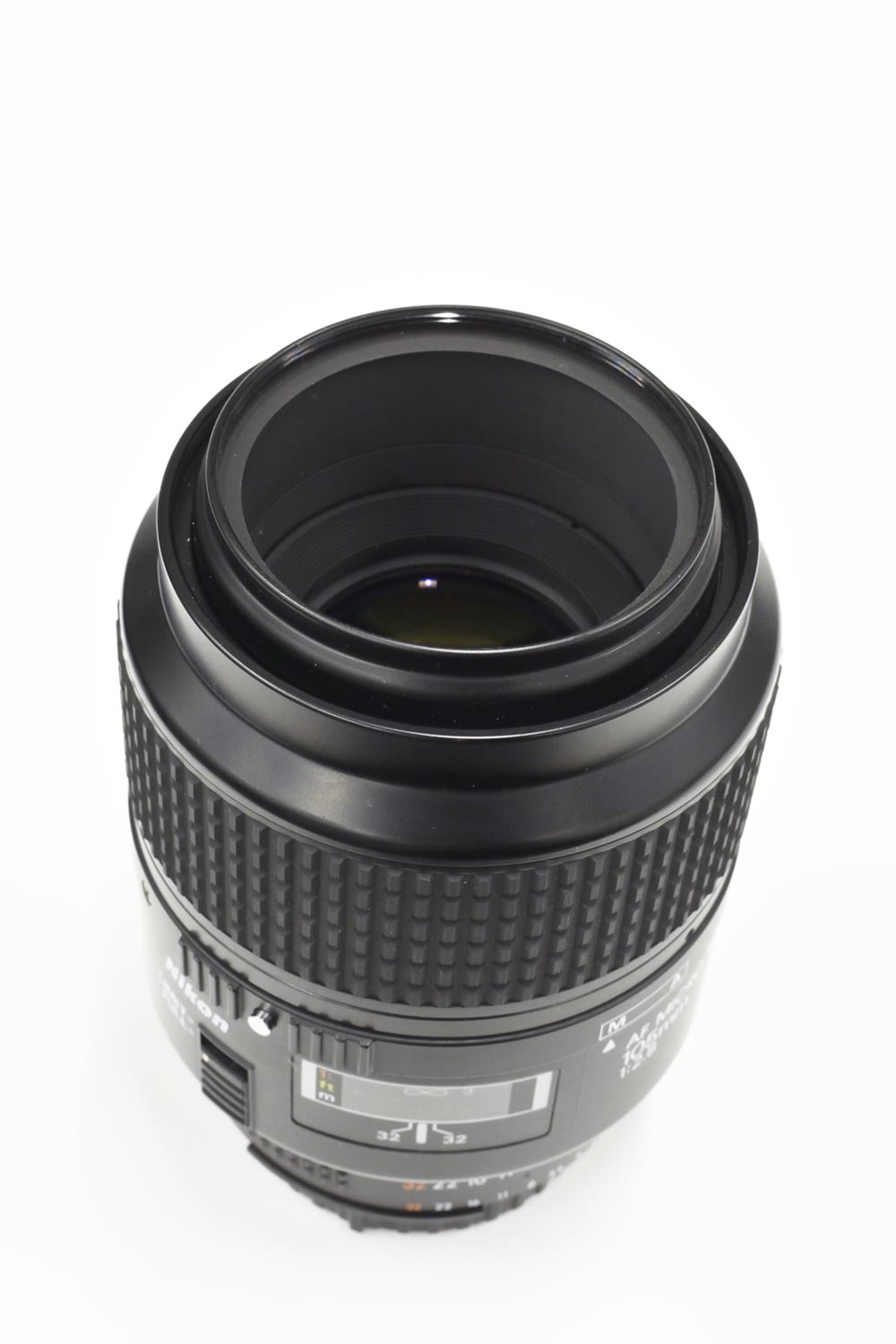
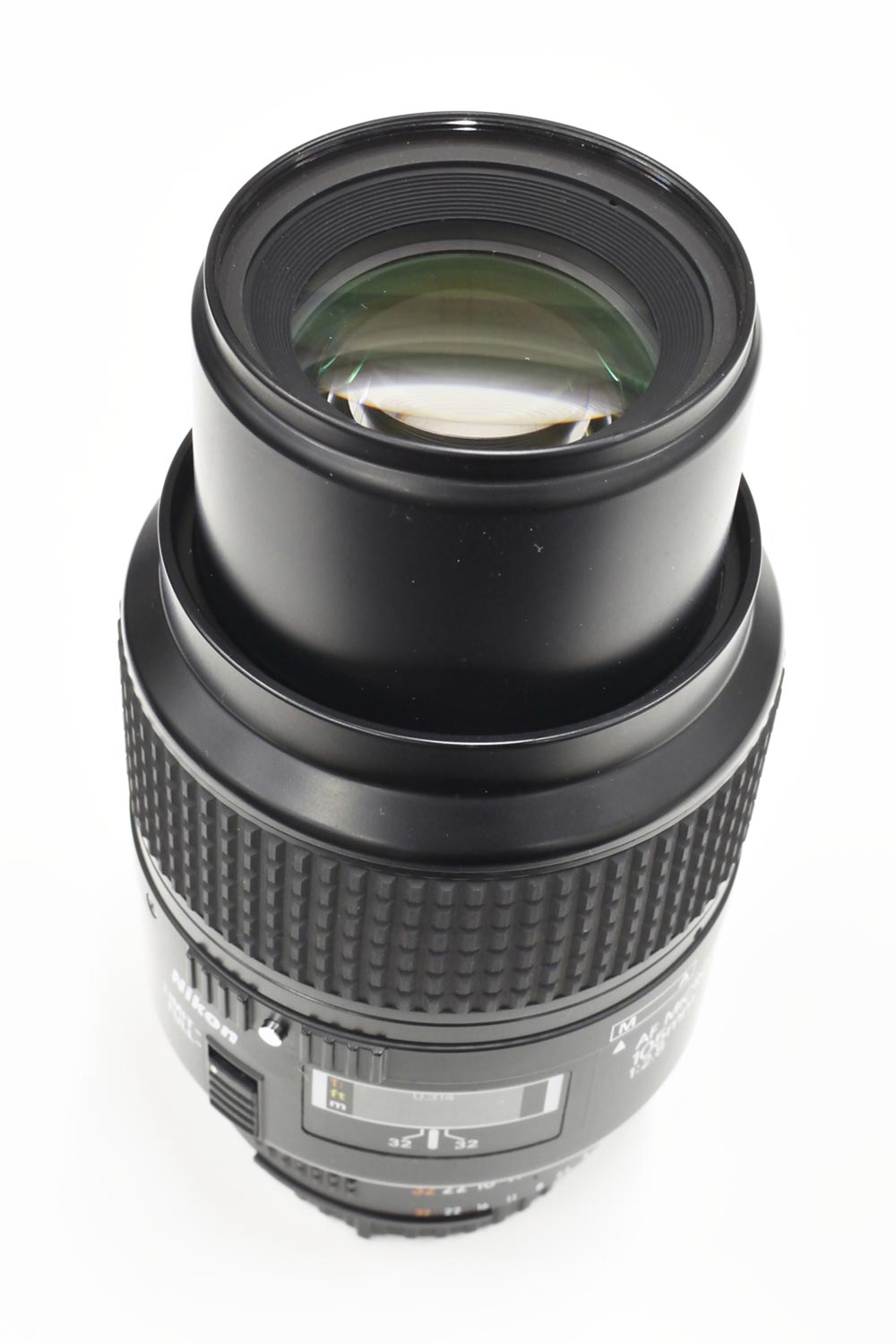
Fig. 1 shows how this lens is constructed. The AI AF Micro-Nikkor 105mm f/2.8S is designed with a modified Gauss-type structure comprised of six elements in five groups with a three-element teleconverter behind this main structure. Three elements in front of the aperture, three elements behind the aperture, and the front two elements in the teleconverter structure combine to form a total of three groups that each moves independently to focus from close-up to infinity. Reducing the amount of movement required by adding a teleconverter behind the Gauss structure followed the AI Micro-Nikkor 105mm f/2.8S upon which this lens was based. The most impressive aspect of this lens is the fact that the three elements in front of the aperture move less than do the three elements behind it, allowing for movement that narrows the aperture space. Hamanishi, who designed the Micro-Nikkor 55mm f/2.8 and the manual focus Micro-Nikkor 105mm f/2.8, says that with Micro lenses, focusing that opens up the aperture space on a Gauss structure is the standard. However, this type of focusing has the drawback of increasing the amount of movement required. Hamanishi was very impressed with the fact that Moriyama was able to maintain performance while reducing the aperture space. Discovering a way to minimize the amount of movement required by the front group made it possible to reduce the amount of movement required by the entire structure.
The barrel structure also contributed to a smaller lens overall. Photo 3 shows the lens focused at infinity, and Photo 4 the lens focused at the minimum focusing distance. As the outer lens barrel extends, the inner barrel, in which the front lens group is incorporated, also extends, generating a large amount of movement. What's more, the outer barrel provides the same effect as a lens hood when focused at infinity, and with close-up shooting, a certain amount of distance from the subject can be maintained (working distance), making it easy to ensure sufficient lighting. As you can see, this structure kills two birds with one stone.
IV. Lens rendering
As always, let's take a look at this lens' rendering characteristics with sample images. The sample images for this Tale were captured using the Z 6 full-frame mirrorless camera and FTZ mount adapter.

Z 6 with FTZ and AI AF Micro-Nikkor 105mm f/2.8S; 1/500 s, f/8, ISO 100, processed with Capture NX-D

Z 6 with FTZ and AI AF Micro-Nikkor 105mm f/2.8S; 15 s, f/4, ISO 3200, 9-shot composite of photos processed with Capture NX-D
Sample 1 is a cityscape shot with aperture stopped down to f/8. The aperture was stopped down so that even the buildings in the background would be in focus. Clearly, the image is sharply rendered all the way to the edges of the frame. Further, very little distortion can be seen despite the fact that the image was captured with a Micro lens.
Sample 2 is a standard summertime starscape centered on the Sagittarius constellation. As this image was made under less-than-optimal conditions highly influenced by light pollution, it is a composite of nine exposures with the same composition that was processed to significantly increase contrast and reduce noise. Processing to increase contrast for results similar to those achieved in starscapes captured at maximum aperture sometimes enhances peripheral illumination falloff (vignetting), but by stopping down the aperture to f/4, that vignetting can be greatly reduced, except at the extreme corners, and completely eliminated at f/5.6. The light cloud visible in the bottom left corner of the image is a part of the Milky Way, the pink object just below the center of the frame is Messier 8 (the Lagoon Nebula), and the blue and pink object exhibiting beautiful contrast just above that is Messier 20 (the Trifid Nebula). Messiers 16 (the Eagle Nebula) and 17 (the Omega Nebula) are included at the top of the image, and the differences in their shapes can be seen. At the mid-telephoto 105 mm focal length, the shapes of nebulae and detailed shading of the Milky Way are visible, making it a good focal length for capturing interesting starscapes.
Sample 3 is a photo of flowers captured at a medium distance at maximum aperture. At this distance, even a standard (not macro/Micro) lens could be used, but the Micro lens provides the security of knowing you could get just a little closer if you wanted to. Captured at maximum aperture, the depth of field is very shallow, making it necessary to focus on a single impressive point. As this sample was captured so that the apparent depth of field could be increased, it was framed to have three flowers at about the same distance from the camera. In-focus portions are sharply rendered, but if you look closely, you'll see that the edges of blurred background portions have a green border and edges of blurred foreground portions have a magenta border. This is the result of axial chromatic aberration, and the blur characteristics (bokeh) may look harsh due to the borders.
Incidentally, when this lens is used with shooting at the minimum focusing distance, an aperture value of f/3 or f/5 may be displayed despite the fact that it was set to f/2.8 maximum aperture. Some will likely find this odd. This occurs because the close-up focusing exposure factor is added to the aperture value, resulting in display of the "effective" aperture setting. With Micro Nikkor lenses, the aperture setting displayed with shooting at infinity, and the effective aperture value displayed with close-up shooting differ greatly. Therefore, the exact effective aperture value is displayed for the user's convenience (see NIKKOR The Thousand and One Nights, Tale 18).

Z 6 with FTZ and AI AF Micro-Nikkor 105mm f/2.8S; 1/2000 s, f/2.8, ISO 100, processed with Capture NX-D
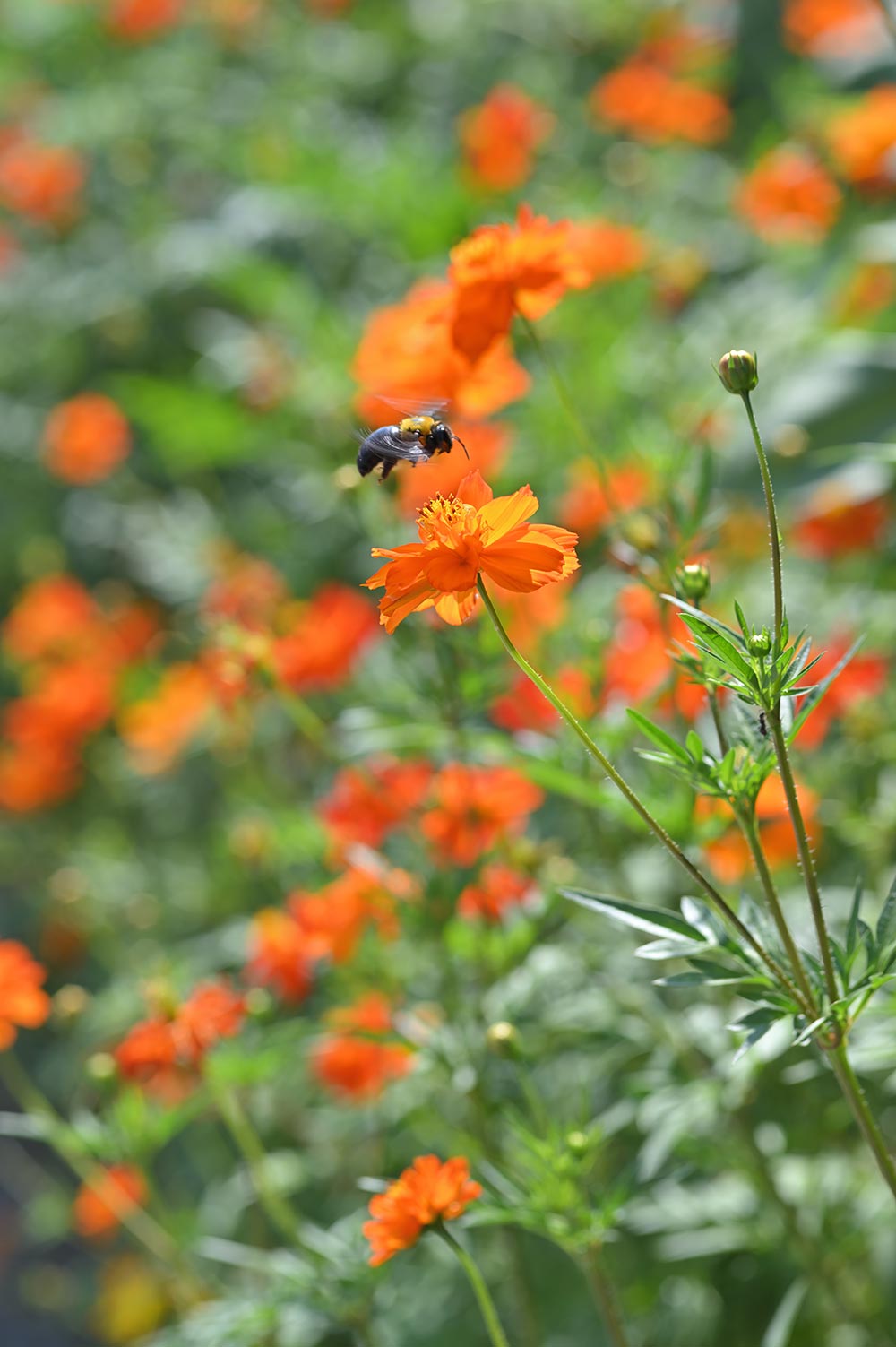
Z 6 with FTZ and AI AF Micro-Nikkor 105mm f/2.8S; 1/400 s, f/5.6, ISO 100, processed with Capture NX-D
Sample 4 is a flower photo shot at a medium distance with the aperture stopped down to f/5.6. By stopping down the aperture, the borders visible in edges of blurred portions in Sample 3 have been completely eliminated. However, the shape of the seven straight iris diaphragm blades is noticeable, and some users may not like it, especially in backgrounds exhibiting such sharp contrast.
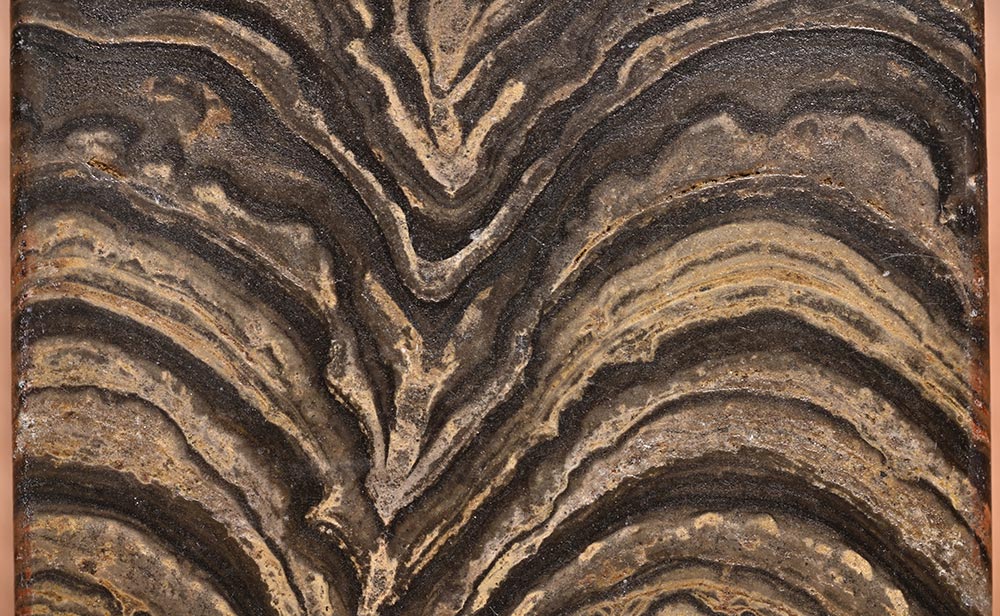
Z 6 with FTZ and AI AF Micro-Nikkor 105mm f/2.8S; 1/10 s, f/11, ISO 1600, processed with Capture NX-D
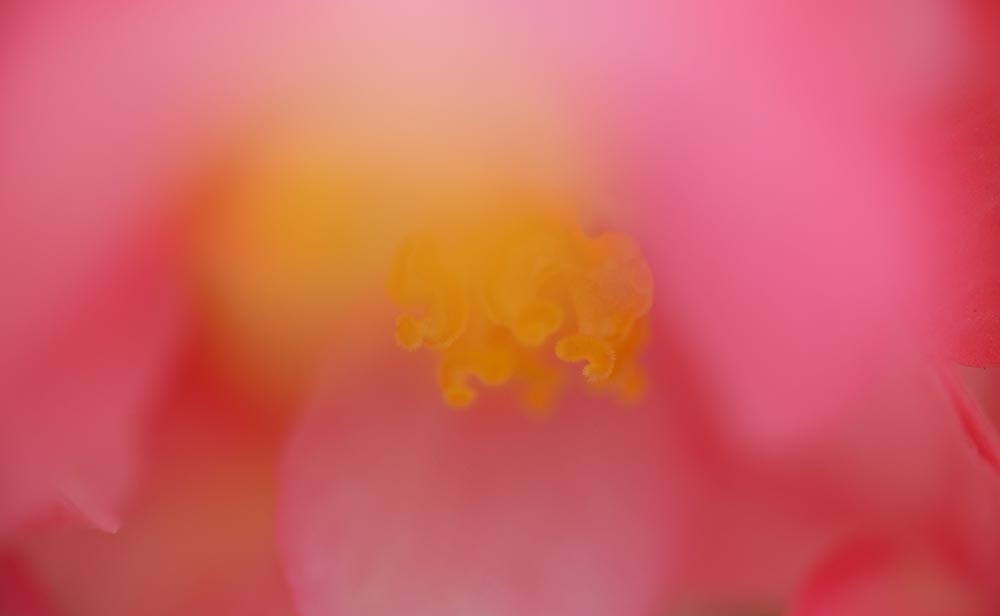
Z 6 with FTZ and AI AF Micro-Nikkor 105mm f/2.8S; 1/250 s, f/5, ISO 500, processed with Capture NX-D
Sample 5 is a 1:1 (life size) photo of a fossilized stromatolite captured at the minimum focusing distance. As the specimen measured just over three centimeters, parts of the long side have been cut off. By enlarging the photo, we can see details of the beautiful, precisely overlapping layers that simply aren't visible to the naked eye. The beauty of nature's modeling is clear. The ability to capture such detail that is not visible to the human eye alone is just one of the thrills users can experience with close-up or macro photography.
Incidentally, it is extremely difficult to achieve images that are sharp all the way to the extreme corners when photographing flat objects like this at the 1:1 reproduction ratio (life size). That is because the depth of field is incredibly shallow. Depth of field with close-up shooting is calculated using the following formula.
(depth of field) = (depth of focus) ÷ (reproduction ratio)2
As depth of field decreases by the square of the reproduction ratio, the depth field that was 100x the depth of focus at the 1:10 reproduction ratio becomes 16x at 1:4, and 4x at 1:2. At the 1:1 (life size) reproduction ratio, the distance between the subject and the lens must be adjusted with the same precision as depth of focus. As depth of focus is calculated using the formula,
±(depth of focus) = (circle of confusion) x (effective aperture value)
depth of field (the same as depth of focus) will only be 0.22 mm when the aperture is stopped down to an effective value of f/11 with a 0.02 mm circle of confusion. Stopping down the aperture to increase depth is normal with close-up/macro photography, but it is important to note that the effect may be very limited. As the edges of the specimen in Sample 5 were curved and polished, an effective aperture value of f/11 was used.
Finally, Sample 6 is a photo of a begonia captured at maximum aperture and the 1:1 (life size) reproduction ratio. Most of the frame is blurred, giving the image a dreamy feel. Those who see it may wonder for a moment what the subject is and how it was shot. The extremely shallow depth of field is another exciting aspect of close-up and macro photography.
V. The joy of life-size photography
The AI AF Micro-Nikkor 105mm f/2.8S released in 1990 and the AI AF Micro-Nikkor 105mm f/2.8D, which was equipped with an absolute distance encoder and released in 1993, were popular with a broad range of photographers as the standard lenses for flower and field photography. Their autofocusing capability was a great advantage because it made it possible for anyone to easily photograph flowers. In addition, the ability to photograph at the 1:1 (life size) reproduction ratio was a huge step forward for Micro lenses, which had previously supported a maximum reproduction ratio of just 1:2. I realized this again when capturing sample images. The look and feel of an image captured at the 1:1 (life size) reproduction ratio is completely different from that of one captured at the 1:2 reproduction ratio. While the jump from 1:4 to 1:2 is a natural extension of the human eye, going from 1:2 to 1:1 is beyond the capabilities of the human eye.
That alone made it very difficult to capture photos like Samples 5 and 6 at the 1:1 (life size) reproduction ratio. With 1:1 shooting, this lens's effective aperture value is f/5. That makes depth of field equal to the thickness of a piece of paper. With subjects like that reflected in Sample 5, a tripod can be used to ensure sharp focus and precise framing. When shooting out in the field, however, there is no way to guarantee where focus will be acquired because even the slightest movement of the air can cause the subject to move. This is unavoidable. As even the slightest change in composition changes the pattern, it is difficult to achieve the intended results, even when taking time to shoot using a tripod. The intended results can best be achieved by capturing multiple shots, adjusting composition and focus position slightly with each as you would with hand-held shooting. In addition, close-up and macro photography often requires the photographer to assume an awkward position, sometimes squatting or even lying down. You may feel it the next day, but these awkward positions often result in the most interesting photos that will encourage you to do it all over again and again.
If you own any macro or Micro lens, whether it be the lens discussed in this Tale or another, I encourage you to try it out with close-up photography of everyday sorts of objects around you. There are even some compact cameras that support close-up shooting with results similar to those achieved with a macro lens. You will be astonished at the details not visible with the naked eye that you may discover in flowers, bugs, and foliage.
Macro lenses serve as your invitation to the macro world.

NIKKOR - The Thousand and One Nights
The history of Nikon cameras is also that of NIKKOR lenses. This serial story features fascinating tales of lens design and manufacture.

